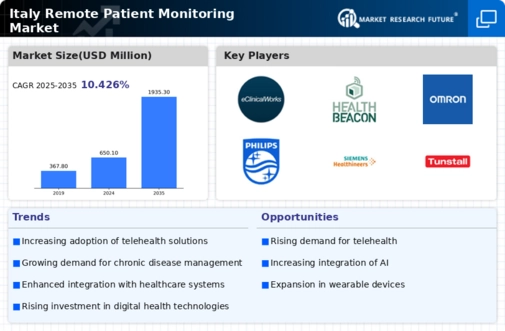Rising Healthcare Costs
Rising healthcare costs in Italy are prompting a shift towards more cost-effective solutions, such as remote patient monitoring. With healthcare expenditures projected to reach €200 billion by 2025, both patients and providers are seeking alternatives to traditional in-person visits. Remote monitoring can significantly reduce costs associated with hospital stays and emergency care, making it an attractive option for managing chronic diseases. As healthcare systems strive to optimize resources, the remote patient-monitoring market is positioned to benefit from this economic pressure, potentially leading to increased adoption rates across various demographics.
Enhanced Data Security Measures
As the remote patient-monitoring market expands, concerns regarding data security and patient privacy are becoming increasingly prominent in Italy. The implementation of stringent data protection regulations, such as the General Data Protection Regulation (GDPR), has compelled healthcare providers to adopt robust security measures. This focus on data security not only protects patient information but also fosters trust in remote monitoring technologies. Consequently, the remote patient-monitoring market is likely to see growth as healthcare organizations invest in secure platforms that comply with regulatory standards, ensuring patient confidentiality and data integrity.
Increasing Demand for Home Healthcare
The remote patient-monitoring market is experiencing a notable surge in demand for home healthcare solutions in Italy. This trend is driven by an aging population, which is projected to reach 23% of the total population by 2030. As more individuals seek to manage chronic conditions from the comfort of their homes, healthcare providers are increasingly adopting remote monitoring technologies. The Italian government has recognized this shift, allocating approximately €1 billion to enhance telehealth services. This investment aims to improve healthcare accessibility and reduce hospital readmissions, thereby fostering growth in the remote patient-monitoring market.
Integration of Artificial Intelligence
The integration of artificial intelligence (AI) into the remote patient-monitoring market is transforming healthcare delivery in Italy. AI technologies enable more accurate data analysis and predictive analytics, which can lead to timely interventions for patients. For instance, AI algorithms can analyze patient data to identify potential health risks, allowing healthcare providers to act proactively. The Italian healthcare system is increasingly investing in AI-driven solutions, with an estimated €500 million allocated for digital health initiatives. This technological advancement is likely to enhance patient outcomes and drive the expansion of the remote patient-monitoring market.
Collaboration Between Tech Companies and Healthcare Providers
Collaboration between technology companies and healthcare providers is emerging as a key driver in the remote patient-monitoring market. In Italy, partnerships are forming to develop innovative solutions that enhance patient care and streamline healthcare delivery. For example, tech firms are working with hospitals to create integrated platforms that facilitate real-time monitoring and data sharing. This synergy is expected to lead to improved patient outcomes and increased efficiency in healthcare services. As these collaborations continue to evolve, they are likely to propel the remote patient-monitoring market forward, fostering innovation and expanding service offerings.



















Leave a Comment